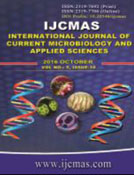


 National Academy of Agricultural Sciences (NAAS)
National Academy of Agricultural Sciences (NAAS)

|
PRINT ISSN : 2319-7692
Online ISSN : 2319-7706 Issues : 12 per year Publisher : Excellent Publishers Email : editorijcmas@gmail.com / submit@ijcmas.com Editor-in-chief: Dr.M.Prakash Index Copernicus ICV 2018: 95.39 NAAS RATING 2020: 5.38 |
This study is a contribution at the conversion of the home scale traditional activity of production of cassava brandy in industrial process of production of bioethanol in Congo. The experimental results show the possibility to control the fermentation of cassava mash by the measure of the density in keeping with starch content. The evolution of the fermentation process of cassava mash depends of the addition of maize malt, source of α-amylase. The number of stages of temperature of distillation process increases when the density of the cassava mash submited to the ethylic fermentation is high. For a cycle of distillation of fermented wort, the temperature of extraction of ethanol is as much down as the initial density of mash on fermentating is higher. The fractions of volume of the distillate proceeding from dense worts are more alcoholic in comparison with those of worts more light. For the mash at 285 g/L of starch, six fractions of volume of the distillate having an alcohometric title superior at 20°GL are collected in comparison with two fractions for the mash at 71g/L. The redistillation process of the fractions of volume of the distillate has permitted to concentrate the alcohol content.
 |
 |
 |
 |
 |